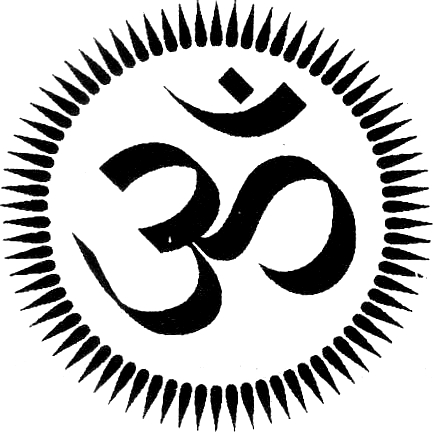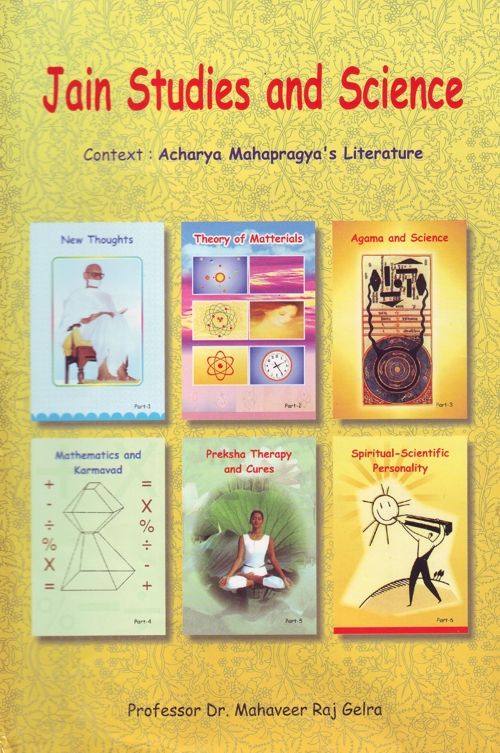According to Mahapragya, The principle of Karma, called karmavad, is the backbone of entire Jain philosophy. Its understanding prompts a human to practice spiritualism. One's Karmas are the blueprint of one's past deeds on which the edifice of present can be constructed and the future course can be charted.
Mahapragya feels a dire need of confluence between the Karma philosophy and the human psychology. A correlation between the two can open the flood-gates of exploration of new capabilities and strengths a human mind can possess. He has tried to associate the theory of karma with not only psychology but with yoga and genetics too.
Karma and Dexterity
Due to lack of proper explanations and half-truths prevailing about the theory of Karma, a vast majority has presumed it to be an inevitable destiny. They have marginalized the role of decisions and dexterity and have heavily banked on the doctrine of fate. For them, everything is predestined. A few others have termed the worldly happenings to be the game plan of Supreme God leaving little space for human endeavour. Mahapragya has tried to dispel these delusions. Karmas are not all that powerful; they can be reined in and altered by the right conduct and efforts. Their effect can be preponed, enhanced, worsened or transformed.
Mahapragya states that Karmavad is a powerful tool to root out the wide spread immorality. It is neither an escapist theory nor it calls for resignation; it's actual, deep and practical meaning is to employ our efforts to modify our present and future for the better.
1. Philosophy of Karma
In all philosophies based on the reincarnation, theory of karma is well established and widely accepted. But, if an unbiased analysis is performed, its full-blown development is seen only in the Jain philosophy. Here, the anatomy, the association with bios, the dissociation through atonement, the transformation through efforts, and the ultimate emancipation are described in great lengths. To explain the diversity of nature, some religions rely upon destiny, some on God, some on probability and so on, but Jains follow the adage of Bhagwan Mahavira as mentioned in the Bhagwati-Sutra that the life's diversity is the direct result of bios' karma.
1.1. Definition of Karma
Different philosophies have their own definition of what karma is? However two broad definitions emerge -
- Mimansak sect, Gita, Yoga & Vedant, they all associate various daily conduct and activities to the Karma. For them it is an abstract term.
-
In Jain Siddhant Dipika, the definition is

This means that the karmas are micro physical bodies (quadon pudgals) which are formed by the righteous and/or unrighteous activities of the bios. Author has coined a new word 'Karmasomes' to distinguish between the physical and abstract forms. In Greek, soma means body, therefore the newly christened word, 'Karmasomes' is meant to represent the karmic body. Its justification will be further obvious as we read about chromosomes in the section dealing with genetics. 'Karmasomes' are formed by quadons (chatu-sparshi pudgals) which are massless and they exhibit affinity towards the soul. This affinity binds the 'Karmasomes' with the soul. Soul and karma thus form a single entity for all practical purposes and they stay together during all cycles of births and re-births. The aim of a spiritually bent person is to unshackle the pure soul out of the attachment of karma. Mahapragya has quoted from the ancient literatures that the karma pudgals (quadons) are so fine that they cannot be detected by any direct means. But indirect evidences obtained by the science for the electrons and photons make us hopeful that one day a direct cause-and-effect relationship could be established between the actions of bios and the formation of karmic micro bodies. Thus in Jain philosophy, Karma is not an abstract; it is a real, physical entity.
1.2. PsychologyMedical practitioners have only recently being able to answer an age old enigma - the human behaviour is acquired by birth or can be moulded by oneself? Initially, Aristotle and Plato, and later on John Lock and David Hume argued that the psychology is built up on experiences. While biologists Jean Jacks, Russo and Kent believed that the human psychology as written in the genes is unalterable. Freud stated that the human personality and behaviour is a total sum of parents, dreams, laughter and sexual activities. Franc Boise gave the similar statement, "Fate and surroundings are responsible factors."
Modern psychology, with the aid of genetic engineering, has reached a conclusion that the diversity in human behaviour is result of heredity and environment both. A group of genes forming chromosomes determine the inherited properties. These chromosomes are the vehicles through which the hereditary qualities migrate from older to the newer generation at the time of fertilization. But, had it been the only factor, all new-borne would be the carbon copies of their respective parents! That being not the case, environment plays an important role too. However, the uniqueness of each individual and most of the times the vast difference in the natures of next and erstwhile generations compel us to seek explanations beyond psychology and genetics.
Mahapragya has deeply studied the Karmic theory and the modern psychology. He states that the Karmic theory can well explain the exceptionality of each and every individual. Life might look like starting from the fertilization, but the soul is pre-existent. The chromosomes are responsible for inherited merit or demerits, but the Karma are responsible for the overall personality and behaviour. While the former are too rigid to be changed or modified physically, the karma can be wilfully altered to enable us to evolve.
1.3. GeneticsFar reaching advances have been made in the field of genetic engineering. Gene is a part of chromosome (a mega-molecule made up of DNAs) and is made of chemical proteins. The word 'chromosome' is made up of two Greek words - chromo (colour) and soma (body). Biologists have established, beyond doubt, that the coded information is carried from generation to generation by the genes, This statement sounds very similar to the karmas carrying information from one birth to the next, In the natural process, these genes undergo a slow change depending upon the climate, environment, nourishment, health, etc. But, biologists are very near to alter the genes chemically to obtain desirable characteristics and attributes of an organism. In some cases, they have been successful to eliminate, in-embryo, certain genes which were carrying the codes of different diseases. With this knowledge, the Darwin's theory of evolution has come full circle; modification of genes to suit and survive in a given environment has now been substantiated. Jain readers must recall here that the mention of various life-forms of Lord Mahavira before his birth as Siddhartha has several parallels with the theory of evolution. In his preceding births -before assuming the human form - Mahavira lived several births in various animal forms, including the one of elephant, lion etc. All these descriptions convey but one fact - how humans have acquired best characteristics to evolve as a superior life form.
2. Types of KarmaEight types of karmas are enumerated in the Jain scriptures. Depending upon the effects, some of them act as inhibitors, like Gyanavarniya (Knowledge-obscuring), others act as catalysts, like Mohaniya (Emotive), while the third category of Ayushya Karma is decisive. With respect to the modern psychology and genetics, two karmas, namely, Gyanavarniya and Mohaniya, are of special interest.
2.1. Gyanavarniya Karma & GenesAs the name suggests, Gyanavarniya Karmasomes are inhibiters of knowledge. Most invertebrates do not have mind, whereas the capabilities of mind vastly vary amongst the vertebrates. In humans, we bifurcate the mind as -
- Audayic or Conditioned mind
- Kshyopashmic or Super mind
Conscious or conditioned mind is the one which we have inherited from generations and is representative of animal behaviour. This conduct is mostly guided by our past Karmas as if the program is already coded into the genes. Another higher level mind is Super mind which is representative of a pure being. It acquires knowledge by way of detaching the Gyanavarniya Karma. It results in human awakening.
2.2. Mohaniya Karma & PsychologyEmotive Karmas are responsible for our psychological behaviour. According to the Jain belief, the human passions of fear, anger, joy, sorrow, love, hate etc. are guided by these deluding set of Karmasomes. Whereas, the biologists hold various hormones responsible for them. Neutralisation of these karmas results in piousness and detachment. Mahapragya has deliberated on this issue at length. He writes, "Everyone knows what is good and what is bad, yet it is not always possible to conduct accordingly. On the contrary, it is the bad tendency who wins over the noble one. People often blame circumstances for any unworthy behaviour but the root cause is the activation of Emotive Karmas. This must be understood. Sthulibhadra stayed at Kosha's house in an explicitly passionate environment for four months of chaturmas without even an iota of temptation. This was his capacity to win over the deluding karmas of Moh."
Onslaught of Emotive Karma results in varied impulses of anger, conceit, obsession, voracity etc. All these emotions vary in their intensities and can be categorised into four stages -
- severe
- intense
- mild
- serene
Practice of equanimity under all circumstances is the key to conquer these emotions. When the intensities of these impulses become thin, we can take first step towards the liberation. So much so from Jain stand-point. From psychological angle also, these emotive impulses are associated with many a diseases. These emotions actually trap us in a vicious circle - more we succumb to temptations, more is our bondage and our sufferings augment.
3. Karma - MechanismAccording to Jain philosophy, when a soul or bio executes a tendency, it simultaneously attracts and repels the fine Karmic substances (karmasomes, as defined earlier in this text). It is the righteousness of the tendency that decides whether the detachment outclasses the attachment or not? These properties of attraction and repulsion are due to the four-some properties of a karma quadon. As elaborated in the discussions of pudgals, karma-pudgals are said to possess four properties of Snigdha, Ruksha, Ushna and Sheit. First two properties of karma-quadon exhibit the philic- or the phobic- tendencies towards the soul. This affinity between soul and karma could be one of the three types -
- Electric - as in positive and negative charges
- Magnetic - as in north and south poles
- Gravitational - as in cosmic bodies. Here it is necessary to mention that the gravitational force is not essentially attractive but could be repulsive as well. Various studies involving the concept of gravitons have revealed this fact.
Here it must be understood that the affinity of soul and karma does not necessarily means that the two amalgamate with each other. They unite to form a pair while retaining all their individual characteristics. It is as if the negatively charged electrons orbit around a positively charged nucleus. There is one more similarity, the bondage between soul and karma could be weak or strong. In Jain Agams, the dynamics of Karma attraction-repulsion has been described when a soul, in its process of liberation is elated to the thirteenth state (Gunsthan). As the soul is in its penultimate state of ecstasy, it cannot accumulate any more karmasomes (karmic pudgals), because it has to be fully free form karmas at the moment of salvation. In this state, the physical activities of the body attract the karmasomes, but the bond is so weak that it is broken instantly. Karmas decay as fast as they cumulate, so that the net result remains naught.
3.2. New ReasoningIn the Acharanga aphorism, it has been said -
- Those who attract Karma; bind them.
- Those who bind Karma; attract them.
- Those who do not attract Karma; do not bind them.
- Those who do not bind Karma; do not attract them.
This universe is completely filled with fine matter. According to science, there is no region of the space which may be empty. The gravitons and the photons are available at the most distant corners of the Universe. The network of the micro matter is extremely mysterious. Today, the science is engaged in the effort of knowing, both the micro and macro through the medium of mathematics. Every event of the past can stays for a long time in space by being changed into a micro-system. Hence the attempts to know the past are continuing. In this space, such micro-systems are available in abundance and are readily available top those who are capable to utilize them. According to Jain canon, there is no possibility of any new event which may not have occurred in the past. It seems that in Jain literature the information available about the behaviour of the micro is consistent with the results of modern science. This is the extraordinary contribution of Jain philosophy that voluminous literature has been written on Karma theory.
4. Karma TransitionAlsdorf, the German Scholar, who has worked extensively on Jain scriptures had once commented that the Jain saints had written maximum volumes on Karmavad and Drishtivad. While Drishtivad, said to be the twelfth Agam, had lost in the oblivion of time, Karmavad's detailed studies are available.
Stating from its definition and arriving at its mechanism, we are now left to deal with the Karma management. Like in any journey, it is better to travel with lighter baggage, in the soul's journey towards freedom, lesser the karma we carry, better it is. A bio's life starts with default karmosomes attached or bonded with its soul. In addition, each soul has a prime characteristic of intelligence. Life is this spectacular contest between the wit of the soul and the power of the karma. Jainism paves a path for the wit and will to win over the control and command of karma.
4.1. TransformationPeople often argue that desire, hunger, anger, et all are written in our genes and bios have little control over them. But, once exposed to the unique teachings of Bhagwan Mahavira, this illusion totally vanishes. According to him, Karmas can be transformed and so can be their effect. And, in this, the human dexterity plays a vital role. Now, even scientists know how to genetically modify a chromosome and also how to transform one chemical element into another. For centuries, the scientific fraternity believed that iron, copper, gold, mercury etc. are basic elements of nature. Later on, while studying the micro construction of elements, they discovered that one element can be transformed into another. We find a specific example of turning mercury into gold by bombarding the former with high energy protons. As a first transition, the proton enters the mercury atom to increase the atomic mass from 200 to 201. This is unstable state, and the excited mercury atom releases an alpha particle having an atomic mass of 4. The resultant atom has an atomic mass of 197, which is identical to that of gold. The new atom thus obtained, has all the characteristics of the genuine gold atom. In the similar way, the dynamism and the dexterity can rewrite the destiny of karma. Human endeavour can transform the effect of providence and can write one's own fate.
4.2. Impulse ManagementThree possible ways are there to control the impulses - suppress, endure or attenuate. Karmavad does not advocate suppression. Stifling ones' desires is always counterproductive. They (desires) bounce back with vengeance. To suffer or enjoy the fate is another way to neutralise the accumulated Karma. The third noble path is to attenuate the rising of karmic desires, to practice equanimity and to understand the duality of soul and body.
Modern day biologists are also successful in altering the effects of diseases and tendencies coded in one's DNA. Nano technology has further heightened the hopes of all our physical and emotional disorders to be treated at 'cell' level instead of at organ level. In this case also, the science is touching the frontiers of finer world which have already been prescribed by the Jain spiritualism. Mahapragya says that there are two types of tendencies in humans -
- Internal tendency
- External tendency
When there is an increase in desire, the person becomes externally tended. When the craving for pleasure is mellowed, he gets closed to the inner self. In the Karmic language, when the indulgence is intense, the person becomes outwardly bound, and when the indifference towards worldly objects augments, the person begins to withdraw into his inner circle. The desires, then, are watered down and the restlessness becomes milder. In the above description Mahapragya has opened the gateway for the comparative study of the Karma science and psychology.
Biologists attribute our emotional impulses to the hormonal secretions. Thyroid, pineal, gonads and adrenal, these glands regulate our physical and mental states. Their study may be useful in diagnosing various ailments, but according to the Karmic theory, the root cause is not the chemical imbalance, it is the karma.

 Dr. Mahavir Raj Gelra
Dr. Mahavir Raj Gelra

